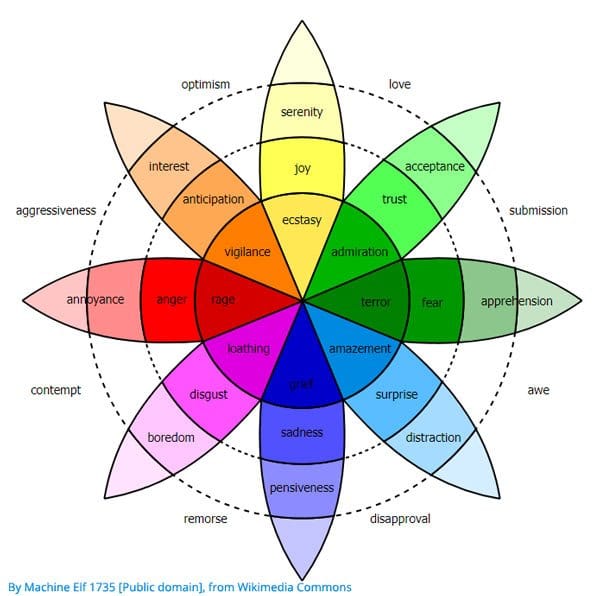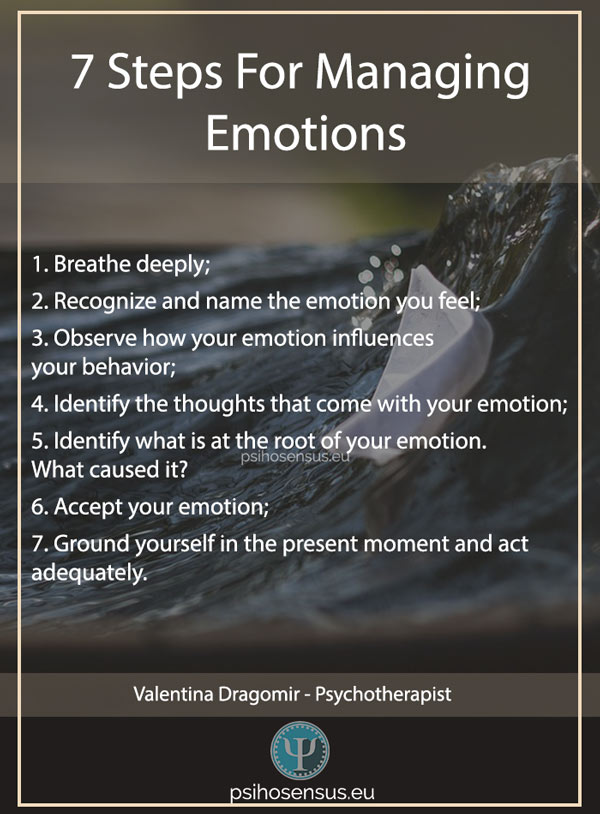Written by Valentina Dragomir, Psychotherapist |

Today we talk about how to manage emotions in 7 simple steps. I will describe each step in detail to help you cope with your emotions.
Our emotions have a great influence on our behavior. When we are not aware of our emotions, they greatly influence our behavior, leading to impulsive actions. Hence sometimes we behave differently than we normally do.
Usually, after doing something impulsive based on our emotions, especially if the emotion is negative, we may feel sorry for acting inadequately, feel regret and tell ourselves we should not have done that.
Although you have strong emotions sometimes and it seems that they’re off the charts, in reality you can control them.
The 7 steps for managing emotions are part of a practical exercise. The purpose of the exercise is to teach you that you are in control of what you say or do and improve your emotional well being. It helps you cope with emotions and develop your emotional intelligence by becoming aware of your emotions and controlling them before they become destructive.
The 7 steps I describe below bring the awareness and the control you need to manage emotions. When I say control, I mean the power to make a conscious decision on our emotions. And I’m not talking about suppressing, hiding, repressing or not expressing emotions.
But first, let’s talk a little bit about emotions, to give you some background info about them.
What are emotions?
The emotions are defined as complex psychological states that can influence our thinking and behavior and are experienced by us through physiological and physical changes.
Emotions are natural; we all feel them in our very personal way. Because we feel them differently (or feel different from other people in similar situations) does not mean that what we feel is inadequate, not real or less important.
Emotions are essentially neither positive nor negative, they are what we feel in response to something. To understand them, it is easier to place these emotions on a spectrum with two poles: positive and negative.
So we have positive emotions like joy, happiness, contentment, admiration, and negative emotions such as anger, sadness, fear, disappointment, shame, guilt.
Negative emotions obviously have a negative impact on us.
For example:
- shame can make us avoid places, people, experiences, or isolate us
- sadness can immobilize us
- anger can make us say or do something aggressive
Expressing negative emotions has a negative impact on us or on other people. This can make us feel ashamed that we have these emotions, and believe that the negative emotions are bad.
And if the emotions are bad, why should we feel them? Don’t we better avoid them, fight against them, or pretend they don’t exist?
Well, that’s not really useful.
You see, when we run away from our emotions or deny their existence, we run away from ourselves, our own feelings. We run away from one of the richest sources of knowledge and development. We don’t allow ourselves to heal or be in touch with reality.
How many types of emotions are there?
Without going into too much detail, there are many types of emotions. The basic universal emotions for humans are six, as the researcher Paul Ekman suggested in 1972: joy, sadness, fear, disgust, anger, and surprise.
These emotions are described in detail in the article The 6 Basic Universal Emotions. Read it to gain knowledge about these emotions.
Subsequently, Dr. Ekman updated the list in 1999 to include enthusiasm, fun, pride, satisfaction, contempt, shame and embarrassment.

Of course, people can feel a great variety of emotions: joy, confusion, jealousy, serenity, love, hatred, shame, acceptance, guilt, admiration, grief, astonishment, disappointment, contempt, and other emotions.
Take this list of emotions to help develop your vocabulary of emotions.
Dr. Ekman is not the only expert in the field of emotions. Below is the emotion wheel described by Dr. Robert Plutchik in the 1980s, also called the Plutchik’s Wheel. In this wheel of emotions, you can see the basic emotions in Plutchik’s vision (the 8 placed in the center), their derivations (on each “petal”), and the complex emotions (those that are not placed on a color).

According to Dr. Plutchik, the basic emotions are: ecstasy, vigilance, rage, loathing, grief, amazement, terror and admiration. The complex emotions are: optimism, aggressiveness, contempt, remorse, disapproval, awe, submission and love.
How do you manage your emotions?
Negative emotions are by far the most difficult to manage and accept. Any of the negative emotions we feel can become overwhelming and we can feel like we lose control of what we do or say.
It is true that managing emotions can be easier for some people and more difficult for others who have suffered trauma, abuse, or simply did not have a model from which to learn about emotions, or there was no one there to mirror their emotions for them. Thus the emotional development suffered.
But it is not impossible to learn to manage our emotions.
So how do we control them before they can control us? Below are the essential steps and their description.

1. Recognize and name the emotion you feel
The first step is to recognize the emotion or emotions that you feel at one time. Awareness is the first step towards managing emotions and a better mood.
You can feel a storm of emotions, one of which is stronger. Is it shame, fear, anger, contempt?
2. Notice how the emotion feels in your body
Emotions manifest in the body when they appear. For example, when we are afraid, we can feel the heart beat harder, certain areas of the body are tense, or we can start having a headache, our mouth can be dry. When we feel sad, we can feel chest pain occurring.
Ask yourself “how do you feel your body when you have that emotion?”.
3. Notice how your emotion affects your behavior
Our behavior is what we do or say. Our emotions have a very strong impact on our behavior. How? For example, you can avoid people or speak aggressively when you feel angry; if you feel jealousy or envy you can make a mean comment; when you feel sad you may want to be alone.
How is the emotion that you feel affecting your behavior? What do you do or say when you have that emotion?
4. Identify the thoughts that come with your emotion
Our emotions are accompanied by thoughts or different beliefs. Our emotions are the expression of our mind in the body, as Eckhart Tolle said.
Identify those thoughts that come with that emotion. For example, some thoughts that generate sadness may sound like: “I can not do this project well. I never do anything good. I’m a loser.”
Listen to your inner dialogue when you feel strong emotions. Write some of these thoughts down.
5. Identify what is at the root of your emotion. What is the cause?
What makes you feel those emotions? Is it something external or internal that caused you to feel that emotion? Or both?
Usually, when we discover the cause of our emotion, we can immediately know what to do to solve the problem. Is the behavior of your colleague that gets on your nerves? Is your internal dialogue that cuts your wings when you want to learn something new?
6. Accept your emotion
Now that you have gone through the above steps, it is important to not judge what you feel, but to accept as a compassionate observer.
Honesty with yourself is an extraordinary bonus and proof of courage. When we embrace the emotions we feel, their intensity is reduced. They no longer control us. Acceptance comes like a healing.
7. Bring yourself to the present moment, here and now and act appropriately
Okay, you’ve become aware of your emotion/s and named it, you’ve seen how your behavior is impacted by your emotion, you observed how you feel in your body when you have that emotion, you’ve seen what your thoughts are and what’s behind your emotion, and you’ve accepted your experience.
What can you do next? Usually, as soon as we discover the cause of something, we know where to look for solutions.
The last step is about what you choose to do when you feel that emotion. Behavior is a choice. You can choose how you want to respond. You can choose your behavior and words so that you can respond the best you can to the situation you encounter.
For example, instead of making a mean comment, you can choose to make a compliment.
Instead of isolating yourself when you feel sad, you can look for friends and you can share with them about how you feel.
Instead of saying things you will regret later, you can choose to communicate and explain what bothers you and channel your resources to find a balanced solution.
Gaining inner peace
Becoming aware of what you feel and making a conscious choice in the here and now helps you gain control of the emotions that you feel. Therefore, you manage your emotions.
This is how you take ownership of the power that you have and you can decide how you want to respond in many situations that arise in your life. As a result inner peace can emerge. As Pema Chördön, a Tibetan Buddhist monk and teacher, said:
Inner peace begins the moment you choose not to allow another person or event to control your emotions.
You can do this exercise whenever you want to check in with yourself to see how you feel. Or every moment you feel strong emotions and you need to be in charge.
Good luck finding and accepting your emotions!
Resources:
- Gross, J. J. (2001). Emotion regulation in adulthood: Timing is everything. Current Directions in Psychological Science, 10, 214-219. DOI: 10.1111/1467-8721.00152
- Ekman, P. (1999). Basic emotions, in Dalgleish, T; Power, M, Handbook of Cognition and Emotion. Sussex, UK: John Wiley & Sons.
- Plutchik, R. (1980). Emotion: Theory, research, and experience: Vol. 1. Theories of emotion 1. New York: Academic Press.



